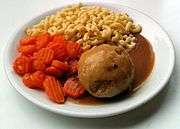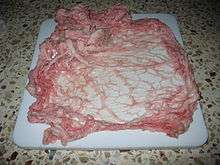Caul fat
Caul fat, also known as lace fat, omentum, crépine or fat netting, is the thin membrane which surrounds the internal organs of some animals, such as cows, sheep, and pigs, also known as the greater omentum. It is used as a casing for sausages, roulades, pâtés, and various other meat dishes.[1] Examples of such dishes are Swiss atriau,[2] French crépinette,[3] Cypriot sheftalia, British faggots,[1] Serbian plućna maramica and trbušna maramica and Italian fegatelli. In the traditional Ukrainian and Russian cuisine, caul fat, known as salnik or salnyk, was usually filled with kasha and liver, and baked in a clay pot in the Russian oven.[4] The Navajo people of the Southwestern United States wrap sheep intestines around strips of caul fat to make a dish called ach'ii'.
- Caul fat dishes
 Salnyk
Salnyk.jpg) Ostrich crépinette
Ostrich crépinette- French veal sausage bundle (Feuilleton de veau)
 Atriau served with pasta and carrots
Atriau served with pasta and carrots

References
- "Caul fat recipes". BBC Food. Retrieved 7 October 2012.
- Association Fribourgeoise des Paysannes (1996). Küche & Traditionen im Freiburgerland (in German). Fribourg: Éditions Fragnière. p. 133.
- "Crépinette". Food Dictionary. Epicurious.com.
- William Pokhlyobkin (2010). "Salnik". The Great Encyclopedia of Culinary Art (in Russian). Moscow: Centrpoligraph. ISBN 978-5-9524-4620-5.